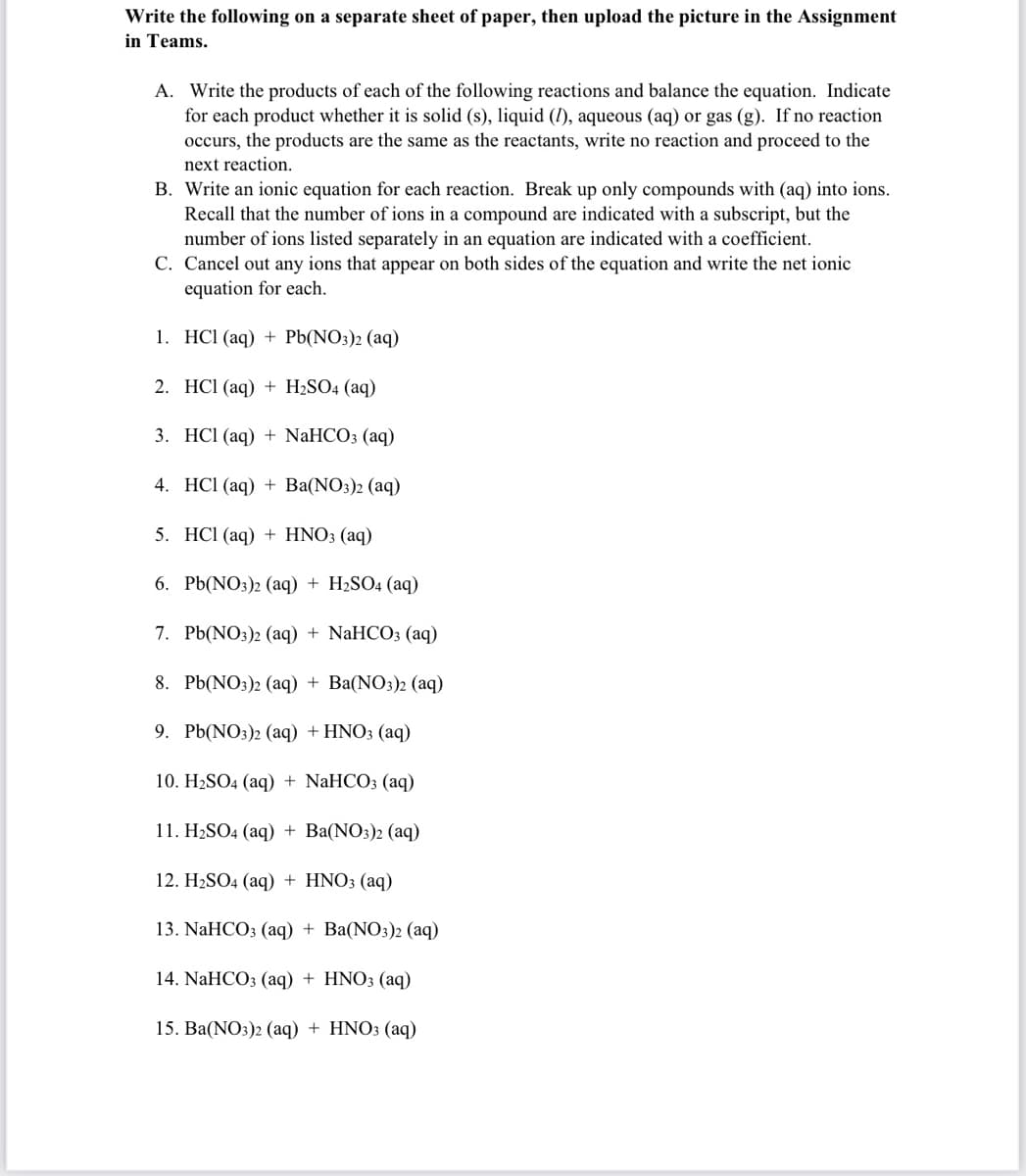uets ing for each product whether it is solid (s), liquid (I), aqueous (aq) or gas (g). If no reaction occurs, the products are the same as the reactants, write no reaction and proceed to the next reaction. B. Write an ionic equation for each reaction. Break up only compounds with (aq) into ions. Recall that the number of ions in a compound are indicated with a subscript, but the number of ions listed separately in an equation are indicated with a coefficient. C. Cancel out any ions that appear on both sides of the equation and write the net ionic equation for each. 1. HCl (aq) + Pb(NO3)2 (aq) 2. HCl (aq) + H2SO4 (aq) 3. HCl (aq) + NaHCO3 (aq)
uets ing for each product whether it is solid (s), liquid (I), aqueous (aq) or gas (g). If no reaction occurs, the products are the same as the reactants, write no reaction and proceed to the next reaction. B. Write an ionic equation for each reaction. Break up only compounds with (aq) into ions. Recall that the number of ions in a compound are indicated with a subscript, but the number of ions listed separately in an equation are indicated with a coefficient. C. Cancel out any ions that appear on both sides of the equation and write the net ionic equation for each. 1. HCl (aq) + Pb(NO3)2 (aq) 2. HCl (aq) + H2SO4 (aq) 3. HCl (aq) + NaHCO3 (aq)
World of Chemistry, 3rd edition
3rd Edition
ISBN:9781133109655
Author:Steven S. Zumdahl, Susan L. Zumdahl, Donald J. DeCoste
Publisher:Steven S. Zumdahl, Susan L. Zumdahl, Donald J. DeCoste
Chapter9: Chemical Quantities
Section: Chapter Questions
Problem 1STP
Related questions
Question
Can you help me solve all these questions

Transcribed Image Text:Write the following on a separate sheet of paper, then upload the picture in the Assignment
in Teams.
A. Write the products of each of the following reactions and balance the equation. Indicate
for each product whether it is solid (s), liquid (I), aqueous (aq) or gas (g). If no reaction
occurs, the products are the same as the reactants, write no reaction and proceed to the
next reaction.
B. Write an ionic equation for each reaction. Break up only compounds with (aq) into ions.
Recall that the number of ions in a compound are indicated with a subscript, but the
number of ions listed separately in an equation are indicated with a coefficient.
C. Cancel out any ions that appear on both sides of the equation and write the net ionic
equation for each.
1. HCl (aq) + Pb(NO3)2 (aq)
2. HCl (aq) + H2SO4 (aq)
3. НСI (аq) + NaHCOз (аq)
4. НСI (аq) + Вa(NO3)2 (аq)
5. НCI (аq) + HNO3 (aq)
6. Pb(NO3)2 (aq) + H2SO4 (aq)
7. Pb(NO3)2 (aq) + NaHCO3 (aq)
8. Pb(NO3)2 (aq) + Ba(NO3)2 (aq)
9. Pb(NO3)2 (aq) + HNO3 (aq)
10. H2SO4 (aq) + NaHCO3 (aq)
11. H2SO4 (aq) + Ba(NO3)2 (aq)
12. H2SO4 (aq) + HNO3 (aq)
13. NaHCO3 (aq) + Ba(NO3)2 (aq)
14. NaHCO3 (aq) + HNO3 (aq)
15. Ba(NO3)2 (aq) + HNO3 (aq)
Expert Solution
This question has been solved!
Explore an expertly crafted, step-by-step solution for a thorough understanding of key concepts.
Step by step
Solved in 2 steps with 1 images

Knowledge Booster
Learn more about
Need a deep-dive on the concept behind this application? Look no further. Learn more about this topic, chemistry and related others by exploring similar questions and additional content below.Recommended textbooks for you

World of Chemistry, 3rd edition
Chemistry
ISBN:
9781133109655
Author:
Steven S. Zumdahl, Susan L. Zumdahl, Donald J. DeCoste
Publisher:
Brooks / Cole / Cengage Learning

Introductory Chemistry: A Foundation
Chemistry
ISBN:
9781337399425
Author:
Steven S. Zumdahl, Donald J. DeCoste
Publisher:
Cengage Learning

Introductory Chemistry: An Active Learning Approa…
Chemistry
ISBN:
9781305079250
Author:
Mark S. Cracolice, Ed Peters
Publisher:
Cengage Learning

World of Chemistry, 3rd edition
Chemistry
ISBN:
9781133109655
Author:
Steven S. Zumdahl, Susan L. Zumdahl, Donald J. DeCoste
Publisher:
Brooks / Cole / Cengage Learning

Introductory Chemistry: A Foundation
Chemistry
ISBN:
9781337399425
Author:
Steven S. Zumdahl, Donald J. DeCoste
Publisher:
Cengage Learning

Introductory Chemistry: An Active Learning Approa…
Chemistry
ISBN:
9781305079250
Author:
Mark S. Cracolice, Ed Peters
Publisher:
Cengage Learning

Chemistry for Engineering Students
Chemistry
ISBN:
9781337398909
Author:
Lawrence S. Brown, Tom Holme
Publisher:
Cengage Learning

Chemistry: An Atoms First Approach
Chemistry
ISBN:
9781305079243
Author:
Steven S. Zumdahl, Susan A. Zumdahl
Publisher:
Cengage Learning

Introductory Chemistry: A Foundation
Chemistry
ISBN:
9781285199030
Author:
Steven S. Zumdahl, Donald J. DeCoste
Publisher:
Cengage Learning